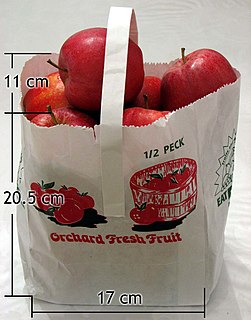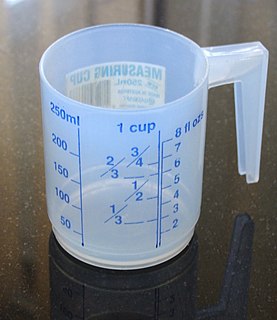
The acre is a unit of land area used in the imperial and US customary systems. It is traditionally defined as the area of one chain by one furlong, which is exactly equal to 10 square chains, 1⁄640 of a square mile, or 43,560 square feet, and approximately 4,047 m2, or about 40% of a hectare. Based upon the International yard and pound agreement of 1959, an acre may be declared as exactly 4,046.8564224 square metres. The acre is a statute measure in the United States and was formerly one in the United Kingdom and almost all countries of the former British Empire, although informal use continues.
United States customary units are a system of measurements commonly used in the United States. The United States customary system developed from English units which were in use in the British Empire before the U.S. became an independent country. However, the United Kingdom's system of measures was overhauled in 1824 to create the imperial system, changing the definitions of some units. Therefore, while many U.S. units are essentially similar to their Imperial counterparts, there are significant differences between the systems.

A peck is an imperial and United States customary unit of dry volume, equivalent to 2 dry gallons or 8 dry quarts or 16 dry pints. Two pecks make a kenning (obsolete), and four pecks make a bushel. Although the peck is no longer widely used, some produce, such as apples, is still often sold by the peck. Despite being referenced in the well-known Peter Piper tongue twister, pickled peppers are so rarely sold by the peck that any association between pickled peppers and the peck unit of measurement is considered humorous in nature.
The gibibyte is a multiple of the unit byte for digital information. The binary prefix gibi means 230, therefore one gibibyte is equal to 1073741824bytes = 1024 mebibytes. The unit symbol for the gibibyte is GiB. It is one of the units with binary prefixes defined by the International Electrotechnical Commission (IEC) in 1998.
The pound of force or pound-force is a unit of force or weight used in some systems of measurement including English Engineering units and the British Gravitational System. Pound-force should not be confused with foot-pound, a unit of energy, or pound-foot, a unit of torque, that may be written as "lbf⋅ft"; nor should these be confused with pound-mass, often simply called pound, which is a unit of mass.
The ounce is a unit of mass, weight, or volume used in most British derived customary systems of measurement. The common avoirdupois ounce is 1⁄16 of a common avoirdupois pound; this is the United States customary and British imperial ounce. It is primarily used in the United States to measure packaged foods and food portions, postal items, areal density of fabric and paper, boxing gloves, and so on; but sometimes also elsewhere in the Anglosphere.

The cubic inch is a unit of measurement for volume in the Imperial units and United States customary units systems. It is the volume of a cube with each of its three dimensions being one inch long.
A system of measurement is a collection of units of measurement and rules relating them to each other. Systems of measurement have historically been important, regulated and defined for the purposes of science and commerce. Systems of measurement in use include the International System of Units (SI), the modern form of the metric system, the imperial system, and United States customary units.
A kip is a US customary unit of force. It equals 1000 pounds-force, used primarily by American architects and engineers to measure engineering loads. Although uncommon, it is occasionally also considered a unit of mass, equal to 1000 pounds, i.e., one half of a short ton. One use is as a unit of deadweight to compute shipping charges.
Pari passu is a Latin phrase that literally means "with an equal step" or "on equal footing". It is sometimes translated as "ranking equally", "hand-in-hand", "with equal force", or "moving together", and by extension, "fairly", "without partiality".

The cup is a cooking measure of volume, commonly associated with cooking and serving sizes. It is traditionally equal to half a liquid pint in US customary units but is now separately defined in terms of the metric system at values between 1⁄5 and 1⁄4 of a litre. Because actual drinking cups may differ greatly from the size of this unit, standard measuring cups are usually used instead.
A lessa was a customary unit of area used in the Indian state of Manipur and neighbouring regions. After metrication in the mid-20th century, the unit became obsolete.
A kattha is a unit of area mostly used for measuring land parts of in Eastern India, Nepal, and Bangladesh. A kattha is roughly one twentieth part of a bigha.
A number of different units of measurement were used in Argentina as its national system was derived from Spanish Castillian. The metric system was legally optional since 1863 and has been compulsory since 1887.
A number different units of measurement were used in Brazil to measure quantities including length, mass, area, and capacity, as those units were derived from Portugal and had significant local variances.
A number of different units of measurement were used in Chile to measure quantities like length, mass, area, capacity, etc. From 1848, the metric system has been compulsory in Chile.
A number of units of measurement were used in Cuba to measure quantities like mass, area, and capacity. In Cuba, Metric system has been compulsory since 1858.





